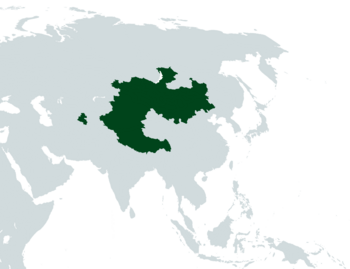Mongol Uls
Khanate of the Mongol Uls Moŋɣol Ulusyn Khanlig | |
|---|---|
| Anthem: Chinggis Khaanii Magtaal | |
 | |
| Capital and largest city | Kharkorin |
| Official languages | Khalkha Uzbek |
| Recognised national languages | Tuvan Buryat Tibetan Uyghur |
| Ethnic groups |
|
| Demonym(s) | Mongol |
| Government | Asymmetric federal parliamentary constitutional monarchy |
• Bogd Gegeen | Manduul Temujin |
• Prime Minister | Etsegh-ek Törin |
| Legislature | Hural Uls |
| History | |
• Onon Kurultai | 1206 CE |
• Qing Conquest | 1758 CE |
• Soviet Occupation | 1921 |
• Coronation of Manduul Temujin | 2019 |
| Area | |
• Total | 3,200,000 km2 (1,200,000 sq mi) |
| Population | |
• 2023 estimate | 21,978,231 |
• 2020 census | 20,023,745 |
| GDP (nominal) | 2020 estimate |
• Total | $73 billion |
• Per capita | $3321.46 |
| Currency | Sum (mns) (MNS) |
| Date format | dd-mm-yy |
| Driving side | left |
| Internet TLD | .ml |
The Mongol Uls, officially the Khanate of the Mongol Uls (Khalkha; Moŋɣol Ulusyn Khanlig), is a nation located in Central Asia. Composed of its heartland, referred to as Mongolia, as well as the federacy of Gurkaniyan, the free city of Kharkhorin, and areas under the jurisdiction of the militant Second Golden Horde, the Khanate claims the legacy of the ancient Mongol Empire.
Etymology
The term "Mongol Uls" can be roughly translated as "Mongol State". The Mongol Uls is often referred to by the metonym of "Mongolia"; however, this is neither the Khanate's official name nor an accurate description, as the Khanate controls territories in areas that are far from the Mongol steppe. Rather, "Mongolia" is a designation for a geographical region within the greater Khanate, which is used for demographic and electoral purposes.